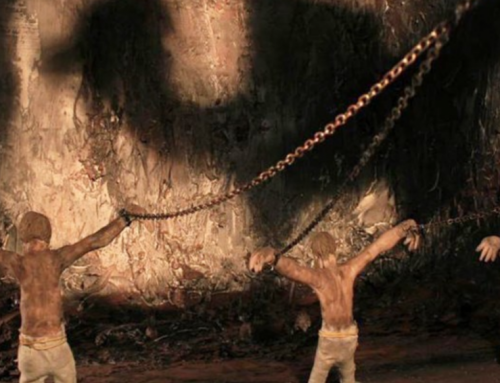… which explains why we have so few great leaders
Three things you might not know
- In order to understand why a tribe of homo sapiens, often called a company or the electorate, behaves the way it does and doesn’t behave the way leadership expects, means leaders must have a multi-layered knowledge of how memes, genes and tribalism interrelate. And it doesn’t come from the typical management theory, it is embedded in sociobiology, evolutionary psychology and anthropology.
- According to Gallup surveys, worldwide, 87% of employees are disengaged from their work. It’s 84% in Canada and 70% in the US. Obviously, most leaders don’t understand human behavior.
- Any fifth-grader knows it’s impossible to effectively operate an organization above a level of mediocrity with 70% of employees disengaged. And yet, most companies keep imitating programs and emulating the leaders who are generating all the mediocrity – leaders continuing to behave as Darwin established 150 years ago, seldom going beyond imitating what their intellect has collected and what their culture sanctions.
(9 minute read)
“No doubt, much of the intelligent work done by man is due to imitation and not to reason; but there is this great difference between his actions and many of those performed by the lower animals, namely, that man cannot, on his first trial, make, for instance, a stone hatchet or a canoe, through his power of imitation. He has to learn his work by practice.” Charles Darwin, The Descent of Man.
 In 1871, Charles Darwin wrote about how his study of animal behavior demonstrated human’s genetic predisposition to imitate rather than reason and how animal imitation builds intuitive, protectional behavior (e.g., bird off-springs imitating parents, young protégés emulating leaders).[1] So despite our vaunted intellectual advantage over other species, we are still saddled with a powerful propensity to imitate instead of reason. And thinking is not reasoning, it’s simply the mechanism for reasoning. We all think, but few venture into the arduous domain of reasoning. Thomas Edison said, “There is nothing man won’t do to avoid the difficult task of thinking” – let alone reasoning. In their book Human Capability, the research of Dr. Elliott Jaques and Kathryn Cason demonstrated that there are four levels of reasoning, each requiring a higher capacity of mental capability (see two earlier blogs: If knowledge were king … and Picking the winner in the presidential debate …). The authors provide a methodology for observing and measuring a person’s reasoning power and they show how to apply the measurement across seven, ever-increasing levels of complexity in the hierarchy of an organization.[2] It’s part of their comprehensive theory developed at the Requisite Organization International Institute for Science Based Management.
In 1871, Charles Darwin wrote about how his study of animal behavior demonstrated human’s genetic predisposition to imitate rather than reason and how animal imitation builds intuitive, protectional behavior (e.g., bird off-springs imitating parents, young protégés emulating leaders).[1] So despite our vaunted intellectual advantage over other species, we are still saddled with a powerful propensity to imitate instead of reason. And thinking is not reasoning, it’s simply the mechanism for reasoning. We all think, but few venture into the arduous domain of reasoning. Thomas Edison said, “There is nothing man won’t do to avoid the difficult task of thinking” – let alone reasoning. In their book Human Capability, the research of Dr. Elliott Jaques and Kathryn Cason demonstrated that there are four levels of reasoning, each requiring a higher capacity of mental capability (see two earlier blogs: If knowledge were king … and Picking the winner in the presidential debate …). The authors provide a methodology for observing and measuring a person’s reasoning power and they show how to apply the measurement across seven, ever-increasing levels of complexity in the hierarchy of an organization.[2] It’s part of their comprehensive theory developed at the Requisite Organization International Institute for Science Based Management.
But mental capability alone is not enough.
“If the world is saved, it will not be by old minds with new programs but by new minds with no programs at all … If we go on as we are, we’re not going to be around for much longer—a few decades, a century at most. If we’re still around a thousand years from now, it will be because we stopped going on as we are.” – Daniel Quinn, Beyond Civilization: Humanity’s Next Great Adventure
The first step in making any change is to face the problem, which, of course, depends on understanding it. When Einstein was asked: “If you had ten days to solve a problem how would you do it?” He answered, “I’d spend nine days on understanding the problem and one on coming up with a solution.” Today, in a world of speed and chaos, leadership spends a day, at most, on understanding problems and the rest of the time driving solutions. Trump’s ramrod approach to healthcare comes to mind, exposing that the Republican’s seven years of opposition ranting (imitating themselves over and over again,) and Trump’s 140 character mental capacity do not constitute understanding a problem. And hundreds of leadership books proffer quick-fixes and re-engineered solutions, which reflect a culture of immediacy and imitation rather than contemplation and comprehension.
Corporate mediocrity
In the corporate world, the incessant pressure to meet quarterly expectations and short-term objectives rather than understand the long-term cause and effect of human behavior is a result of boardrooms full of non-Einsteins. Few leaders are inherently interested in the long-term, particularly if it means sacrificing short-term gains. And much of consulting and academia seldom get out of their silos and explore the connection between leadership and a deep, cross-functional understanding of cultural memes, human genes and the innate forces of human tribalism.
 An example: Three consultants at the firm CultureSync wrote a book, Tribal Leadership, which offers a few principles and excellent methods, practices, tips and “cheat sheets” about how to be a tribal leader, and it references their contemporary research. But there is only a cursory effort at describing or explaining how one might acquire a deep-rooted understanding of human tribalism. Of course, they address “leveraging core values and aligning on a noble cause” but so do thousands of other consultants. There is no reference to the findings of biologists, anthropologist and evolutionary psychologists like Edward O. Wilson, Claude Lévi-Strauss or Daniel Dennett. Cramming big ideas into narrow boxes – and books – just to feed the programmatic minds of leaders does more harm than good. Charlie Munger said in one of his famous speeches, “You’ve got to have multiple [mental] models because if you just have one or two that you’re using, the nature of human psychology is such that you’ll torture reality so that it fits your models, or at least you’ll think it does….” Munger’s concept of mental models anchors reasoning in a general understanding of the three big buckets of knowledge: Physics/math, biology and human history. As Shane Parrish of Farnum Street articulated, “Physics and math, from which we derive the rules the universe plays by; biology, from which we derive the rules life on Earth plays by; and human history, from which we derive the rules humans have played by.”
An example: Three consultants at the firm CultureSync wrote a book, Tribal Leadership, which offers a few principles and excellent methods, practices, tips and “cheat sheets” about how to be a tribal leader, and it references their contemporary research. But there is only a cursory effort at describing or explaining how one might acquire a deep-rooted understanding of human tribalism. Of course, they address “leveraging core values and aligning on a noble cause” but so do thousands of other consultants. There is no reference to the findings of biologists, anthropologist and evolutionary psychologists like Edward O. Wilson, Claude Lévi-Strauss or Daniel Dennett. Cramming big ideas into narrow boxes – and books – just to feed the programmatic minds of leaders does more harm than good. Charlie Munger said in one of his famous speeches, “You’ve got to have multiple [mental] models because if you just have one or two that you’re using, the nature of human psychology is such that you’ll torture reality so that it fits your models, or at least you’ll think it does….” Munger’s concept of mental models anchors reasoning in a general understanding of the three big buckets of knowledge: Physics/math, biology and human history. As Shane Parrish of Farnum Street articulated, “Physics and math, from which we derive the rules the universe plays by; biology, from which we derive the rules life on Earth plays by; and human history, from which we derive the rules humans have played by.”
I mention the Tribal Leadership book to exemplify how even esteemed PhD consultants are inclined to tailor their knowledge to quick-study solutions within their purview to suit leader’s propensity to look for easy-to-imitate, programmatic practices. Such approaches are like emergency room triage in that they aren’t designed to provide long-term solutions, they’re goal is to staunch the bleeding from band-aid programs. To stretch the metaphor, we don’t need more emergency leadership, we need leadership that is dedicated to immersion in multi-faceted surgery and the long-term diagnosis of the human condition. Daniel Kahneman, author of Thinking Fast, and Slow, warns that what is perverse about actually thinking that we “know” something is that it perpetuates a pernicious illusion that we then imitate. It’s very Darwinian to think we know things, or that consultants do, because it let’s us off the hook of deep reasoning. But that’s what we do, “going on as we are,” imitating and practicing survival in the short-game rather than attempting to better understand the big concepts that link human behavior to the human condition.
Tribes don’t disengage, employees do
Many leaders proclaim to have the reasoning capability – or rely on human resource departments – to understand human behavior, but few delve into sociobiology, evolutionary psychology and anthropology in order to understand why a tribe of homo sapiens, often called a company, behaves the way it does, and doesn’t behave the way leadership or society needs. And compounding this cognitive veneer, most leaders behave just as Darwin predicted, seldom going beyond imitating what their intellect has collected and what their culture sanctions. Thus the great disconnect. According to Gallup surveys, worldwide, 87% of employees are disengaged from their work. It’s 84% in Canada and 70% in the US. Any fifth-grader knows it’s impossible to effectively operate an organization above a level of mediocrity with 70% of employees disengaged. And yet, most companies keep imitating programs and emulating the leaders who are generating all the mediocrity.
 As Daniel Quinn sets out in his book Beyond Civilization: Humanity’s Next Great Adventure: “If we’re still around a thousand years from now, it will be because we stopped going on as we are.”
As Daniel Quinn sets out in his book Beyond Civilization: Humanity’s Next Great Adventure: “If we’re still around a thousand years from now, it will be because we stopped going on as we are.”
How can we expect to reach a comprehensive understanding of why we do what we do, and expect to “stop going on as we are,” if our leaders don’t have a multi-layered knowledge of how memes, genes and tribalism interrelate?
As Moore’s Law has proven, we can rapidly innovate technologically – from stone arrowheads to artificial intelligence – and since the industrial revolution, we have advanced through incremental improvement and the practice of imitation. Technologically, many of our leaders are whizzes but when it comes to human behavior most are dunces, and our overall ability to innovate in the field of human behavior is only slightly ahead of the Neanderthals (we modern humans are genetically 99.7% the same as Neanderthals). As homo sapiens, we are slowly evolving as a species with tens-of-thousands of years of practice and yet, in the epoch we call “Western civilization,” our basic human behavior has advanced very little. We are dominated by our biology, and until our human gift of cognition reaches beyond our genetic propensity to imitate and emulate – creating an extremely narrow western-style perspective – we do, as Claude Lévi-Strauss, stated, “… run the risk of becoming ungovernable in the near future.” As I quoted Edward O. Wilson in an earlier blog, (The hypocrisy of democracy is the elephant in the room), “The species lacks any goal external to its own biological nature.”
“Long an act of faith, the belief in a material and moral progress destined to go on forever is facing its gravest crisis.” – Claude Lévi-Strauss, Anthropology Confronts the Problems of the Modern World.
Corporate tribes
The answer as to why corporate leaders, human resource professionals, political leaders and a bevy of consultants do not submerse themselves in learning the connecting web of biology, social sciences and management is, ironically, in the very study of these disciplines. Most leaders don’t study the human condition because of they do not know enough about the root causes of our Darwinian nature. It’s easier and quicker to imitate and make incremental advances on familiar, and superficial, methods rather than invest in the prolonged study, and strategic application of, an advanced understanding of the human condition.
“Humans living in tribes was as ecologically stable as lions living in prides or baboons living in troops. The tribal life wasn’t something humans sat down and figured out. It was the gift of natural selection, a proven success—not perfection but hard to improve on. Hierarchalism, on the other hand, has proven to be not merely imperfect but ultimately catastrophic for the earth and for us.” – Daniel Quinn
Although human hierarchial structures and methods of organizing are, generally, antithetical to human tribalism, the exception is Dr. Elliott Jaques’s theory of Requisite Organization. Dr. Jaques demonstrates in his seminal book, Requisite Organization, that hierarchy is not the problem because it’s a natural form of organization (i.e., lions, baboons, humans). The problem is the lack of understanding and application of the requisite principles, systems and practices that enhance human behavior in a hierarchy.
If leaders want to go from good to great, they should, at the very least, begin to explore the findings of great minds like Charles Darwin and Adam Smith (not from the The Wealth of Nations but from his earlier book, The Theory of Moral Sentiments), and contemporaries like Edward O. Wilson, Richard Dawkins, Ernst Mayr, Daniel Quinn, Claude Lévi-Strauss, Elliott Jaques and Daniel Kahneman.
Memes
Richard Dawkins, author of The Selfish Gene (1976), coined the word meme to describe how individuals are the building blocks of a culture and like genes they constitute the make up and behavior of a body, in this case a cultural body – a tribe. Tribes of people and their collective beliefs, values, thoughts, needs and desires form culture memes (Tribal Leadership did cover this).
 The interaction of cultural memes and genes, over time, is complex, and beyond the scope of this conversation, but there are findings that suggest cultures can affect incremental genetic adaption and that human biological behavior in groups has both a competitive, “survival of the fittest” component and an altruistic, cooperative component.[3] They coexist and the balance between individual competitiveness and altruistic cooperation has a lot to do with the success of any tribe.[4] Tribal leaders (corporations are replete with them) cannot effectively lead if they don’t understand and harness the genetic realities that manifest in cultural memes – and they can’t if they don’t study these disciplines. And if they don’t, eventually the tribe will either ignore them (disengagement) or eliminate them (employee turnover).
The interaction of cultural memes and genes, over time, is complex, and beyond the scope of this conversation, but there are findings that suggest cultures can affect incremental genetic adaption and that human biological behavior in groups has both a competitive, “survival of the fittest” component and an altruistic, cooperative component.[3] They coexist and the balance between individual competitiveness and altruistic cooperation has a lot to do with the success of any tribe.[4] Tribal leaders (corporations are replete with them) cannot effectively lead if they don’t understand and harness the genetic realities that manifest in cultural memes – and they can’t if they don’t study these disciplines. And if they don’t, eventually the tribe will either ignore them (disengagement) or eliminate them (employee turnover).
“Genes leap from body to body by way of reproduction. Memes leap from mind to mind by way of communication.” – Daniel Quinn.
 Tribalism
Tribalism“Now that Western-style civilization no longer has the resources to regenerate itself on its own and to thrive once again, can it learn something about humankind in general, and about itself in particular, from the humble societies, those long held in contempt, which until relatively recently had escaped its influence?” – Claude Lévi-Strauss
According to Levi-Strauss, it is from diversity and collaboration that cultures progress; conversely, they decay from homogenization.[6] In other words, every tribe – from Melanesian to American and Canadian and from religion to race – can only achieve progress and long-term success through diversity. Survival depends on it. This is contradictory to the current trend that is globalizing civilization, dominated by the cultural memes of Western society.
The concept of a closed, inward-looking, protectionist society is the antithesis of progress and a barrier to any culture surviving in the long run. At a more micro-level, teamwork – tribalism – whether across a nation or company or single team, can only work when diversity collaborates, and collaboration can only happen when it is grounded in a sound understanding of how human behavior and tribalism have been, and always will be, fundamentally intertwined.
Great leadership, isn’t; unless it has a deep understanding of memes, genes and tribalism.
- The Descent of Man, Charles Darwin, p. 45
- Human Capability, Dr. Elliott Jaques and Kathryn Cason, pp. 30-38
- Richerson, P.J. and R. Boyd. 2001. Culture is Part of Human Biology: Why the Superorganic Concept Serves the Human Sciences Badly.
- The Social Conquest of Earth, Edward O. Wilson, Chapter 6, p. 55 and Chapter 24, p. 243
- Anthropology Confronts the Problems of the Modern World, Claude Lévi-Strauss
- Ibid, p. 121







Leave A Comment